Chapter 3
digital multi-track recorder.
SONY’s professional digital multi-track recorder models, the PCM-3324 and PCM-3348
were widely accepted around the world in the recording scene of the 1980s and 1990s.
They played a huge role in recording the digital audio used as the source of recorded sound
for CDs distributed worldwide, and one could say that everybody should have heard of their sound.
In this chapter, we are going to hear some stories from those people who were involved in their development,
and users of these two products which had become de facto standards in studios around the world.
A recording/mastering engineer for Sony Music Studio Tokyo. He started his career at the old CBS Sony Shinanomachi Studio, and worked on a wide variety of projects, including live recordings at music halls, and recording and mastering of many musicals and jazz sessions. In this chapter, we’ve asked him to look back and comment on the PCM-3324 and PCM-3348.

A recording engineer at Sony Music Studio Tokyo, with a career spanning more than 30 years, he worked at the Old CBS Sony Roppongi Studio and Shinanomachi Studio, specializing in Pop and Rock and Roll. He has worked with numerous artists including Shogo Hamada, Koji Tamaki and others. Along with Suzuki, we also asked Matsuo to talk about Sony’s digital multi-track recorders.
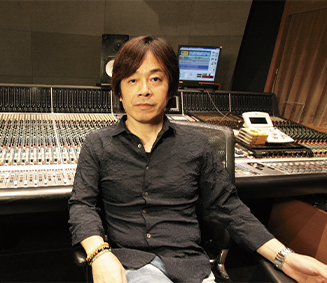
The PCM- 3324, which had a newly-developed AD/DA conversion system,
and also allowed for direct tape splice digital editing.
Since we now have DAW systems available to almost anyone, digital multi-track recording has become common, especially in home studios. It is no longer impossible to overdub any desired numbers of tracks. Yet, before the 1990s, and during times when no affordable hard drives were available, digital multi-track recorders, such as the PCM-3324 and PCM-3348 were the standard devices most often used.
The 24 track PCM-3324 was released in 1982, and the later 48 track PCM-3348 was released in 1989. Both of these models used half inch tape (SONY D-1/2-2920, for example) and enabled 16-bit/44.1 kHz or 48 kHz recording/playback. Digital multi-track recorders were already in the market from another manufacturer, having released their first device in 1978, but the latecomer Sony’s products then became the global standard in the 1980s and 1990s.
“Considering the operability and sound quality needed for a new digital multitrack, we listened to and considered the very severe requirements told to us by people in professional recording situations, and carefully chose the most important features they suggested.” states Kazuyoshi Ebata, who was involved in the development of the PCM-3324. There were big tasks to overcome at the time, before we could present our new digital multi-track recorders to recording engineers who were so used to working with analog multi-track recorders, while being sure to bring our new features to a useful level.
“Around 1979, Sony had developed the first PCM-3324 digital multi-track recorder, and we tried to bring them to recording studios. But then, what was being pointed out was that “It couldn’t be used in actual recording unless it had a function to handle direct tape splice editing.” It had to have a clean sound, even after the knife-spliced tapes were connected back together. Editing with direct cutting of the tape was impossible with the devices from other manufactures at that point, but there was no way to find a place in recording studios unless both analog- and multi-track recorders could be used in the same way. So, we had no option other than making it possible. As a result, we had to introduce the processing circuit needed for direct tape splice editing in the PCM-3324. Using a method called interleaving, we had managed to record the data by scattering it around in various areas of the tape, so that even if the sound has been destroyed where the tape had been cut, data could be brought back intact from somewhere else on the tape, not impacted by the tape splice. It had made it possible to prevent an audible drop-out, and since we had learned how to engage a digital crossfade at the editing point, it was easy to achieve a clean result. These several new digital editing functions were designed by innovative engineers with an unfettered mind and clear purpose, and it came to happen.”
The internal circuits that handled the analog-to-digital conversion of the audio were the key to the sound of Sony’s digital audio devices, and we also conducted unique listening trials which reflected comments from users.
“The most important thing was the AD/DA converter.” Ebata states.
“We tried using off-the-shelf AD/DA converters made by other manufacturers, but what Sony could do was to develop them by ourselves, and I was assigned to be the designer. Audio devices back then generally used AD/DA converters based on what was referred to as “successive approximation type AD Converters”, but this couldn't eliminate the distortion around 0V, and could not recreate low volume sounds clearly enough. So, we developed the double integral AD converter, referred to as a “counter type”, enabling a more detailed recording of the music with a much wider dynamic range.”
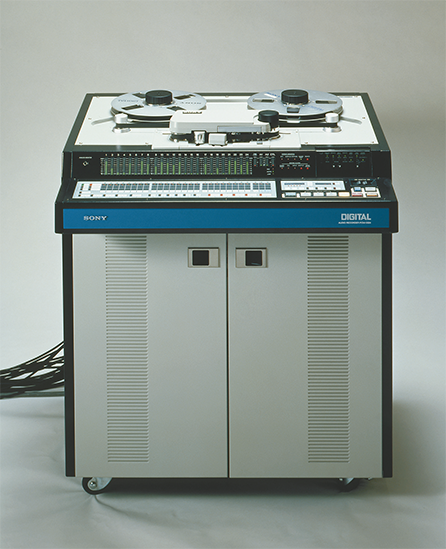
1 : The PCM-3324 24 channel digital multi-track recorder, released in 1982, started mass production in 1984. Priced at about $150,000 at the time, this was truly a professional device. Recording on ½ inch width magnetic tape, to the younger generations familiar with only NLEs, hard disk drives and SSDs for “digital recording”, this should be a surprise. Tape recorders were necessary for multi-track recording and needed consoles for mixing levels and controlling EQ, for example.
A design to have even levels in the recording of instruments
that have richer and more super high-frequency characteristics.
Ideas for how to record super high-ended instruments in even levels.
Analog low-pass filters that were placed before the AD converter and after the DA converter were one of the keys for achieving higher sound quality.
“In accordance with the sampling rate of the 44.1kHz AD converter, we had to create filters that could surely eliminate sounds above 20kHz. Without that, it was possible to have noises when signals above the Nyquist frequency of 22.05 kHz were recorded. Also, a lot of higher harmonics had occurred after the DA conversion that we needed to filter out.”
“If steep filters were used to eliminate these higher frequencies all at once, a lot of distortion could happen. Our idea was to combine 4 second order filters and a single order first filter, combining for a total of 9 stages, necessary to filter out above 20kHz. At the testing stage, we had opinions such as “When high register instruments are playing above a certain range, it tended to become a sweeter tone, or sometimes could be heard as if the volume was getting smaller.” When we tried to figure out what was happening, we found that among the distortions occurring within the filters, higher harmonics above 20 kHz were eliminated and therefore, unheard. Depending on the input source, a large energy loss was happening. That had resulted in a reduction of the output level even though their input level was raised, and unfortunately, the sound got dull too. In order to overcome this problem, we had changed the types of operational amps used and their power allocations in order to avoid this “insufficient reproducibility of the recorded sound on certain instruments”. Probably, if we were testing only with sine waves, we couldn't have responded to what the recording engineers had commented on.”
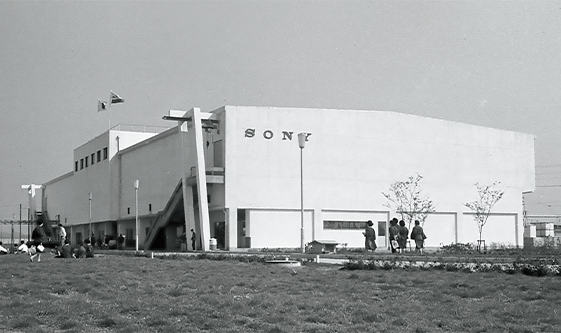
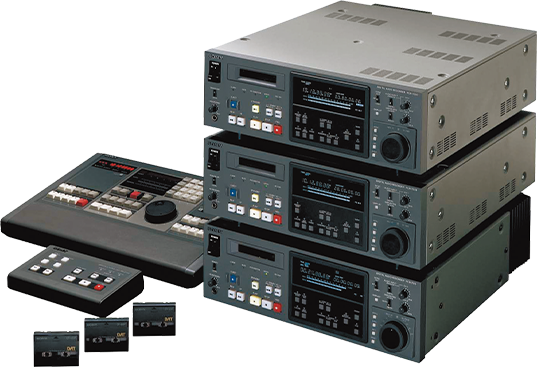
1 : The factory in Atsugi City in Kanagawa Prefecture, where development of the PCM-3324 and PCM-3348 took place. The design group for digital audio was established right after Kazuyoshi Ebata, who had worked on the PCM-3324, had joined Sony.
2 : The PCM-7000 series is comprised of professional use DAT recorder/players and editor. Ebata was involved in the development of the PCM-7010 recorder/player (picture on the right), which had the clock circuit of the PCM-3324. The PCM-7000 series (7010, 7030, and 7050) was introduced in the 1990s.
A very ‘true to original’ and ‘clear sound’ quality,
and free from operational stress.
The PCM-3324 was developed from the users’point of view. To learn how it was accepted in professional recording applications, we’ve interviewed Koji Suzuki and Junji Mastsuo, both recording engineers that know quite well the time back then.
“In 1985, when I had joined the old CBS Sony Shinanomachi Studio, digital recording with the PCM 3324 was already well established” Suzuki states.
“Talking about sound quality with digital recording, the S/N ratio had dramatically advanced from what we experienced with analog multi-tracks. We had to be careful on overloading the input level, but even with the low recording level, we never had a S/N ratio be dramatically worse. When we played back, no hissing noise could be heard and since the sound emerged from a very silent state, everybody was surprised the first time they heard that (laugh). Analog tapes have their own beauty in the unity of sound and its saturation, but when we consider the accuracy of the reproduction of the original sound, I knew the PCM-3324 was ahead. Even though it was digital and the recording was done on tape, we could not eliminate the possibility of physical damage to the tape, but those risks had been avoided by the error correction function.”
Depending on what instruments were to be recorded, we sometimes switched between the PCM- 3324 and analog multi-track recorders. Matsuo states as follows.
“For example, those instruments like drums, which we desired to have tape compressions added, were recorded by analog. But when it came to auto punch in/out, fast forward/rewind, and preciseness of the locator, the PCM-3324 was obviously ‘effortless’. Also, in times of analog tape technology, the recorded tapes sometimes transferred or lost some of their information while they were being stored and preserved. Of course, with digital recording, those problems were solved, and the sound was kept fresh until they were mixed.”
As previously stated, the PCM-3324 was the first digital multi-track recorder that had been used around the world, and of course it had been highly evaluated. Troy Germano, who currently runs Germano Studios, and is also known for having run The Hit Factory Studios in New York City, states as follows.
“We owned 5 of these tape machines. They were used extensively on the “Graceland” album by Paul Simon as well as the “Born In The USA” album by Bruce Springsteen & The E Street Band (both recorded at The Hit Factory, New York City). These tape recorders were sonically superior to any other recorder on the market.”
The PCM-3348 had improved its record/play precision
and lowered the magnetic flux leakage between tracks.
The PCM-3324 was able to sync multiple machines and could handle sessions with more than 24 tracks, but there were still musicians and engineers who wished to carry out digital multi-track recording incorporating as many tracks as possible on a single device. This dream was realized by the PCM-3348.“It was a difficult task to fill 48 audio tracks within 1/2 inch (12.7 mm) width tape.” states Hideo Kawachi, who had worked on the mechanism during the development of the PCM-3348.
“Between the tracks on the tape, there were blank spaces called guard bands which suppressed the interference between the tracks due to magnetic flux leakage during the recording process. But when it came to incorporating 48 tracks, the width of the guard band had to become much narrower. As a result, the error rate became worse and we assumed that it would no longer be able to record. In order to solve this issue, we developed a system called “pulse train recording”. It was basically designed to not let the current flow into the adjacent tracks at the same time, quickly switching the timing of the current flow between adjacent tracks to avoid this interference between tracks. In order to reduce the magnetic flux leakage between the tracks, we had also developed a thin film recording head by applying semiconductor technology needed to replace conventional ferrite core designs.”
The biggest struggle was the development of the playback head. “It was this that really had consumed a lot of time, greatly adding to the total 5 years of time needed for developing the PCM-3348” Kawachi continues.
“Even as with the recording head, and that it was so hard to lower the magnetic interference between tracks, development of the playback head was an even more difficult task. The magnetic flux leakage was so horrible that it was almost impossible to extract the signals. So, we had a challenge to design the head as small as possible to suppress this magnetic flux leakage. But when we had gone to the factory at Sendai with our blueprints (now called Sony Storage Media Manufacturing), we were told that it was “too small to produce.”. But I kept asking, and that resulted in me joining the prototype production team, and we were successful in producing a head which could handle all 52 tracks, including audio and time code tracks. We then brought it back to Tokyo, and after installing it in the prototype of the PCM-3348 , the result was quite good. This was the morning of the day of the press announcement, so we were down to the very last minute (laugh).”
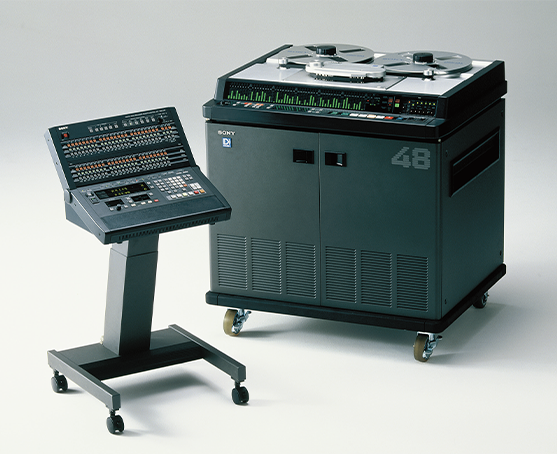
1 : PCM-3348 48 track digital multi-track recorder (pictured on the right) and its remote controller RM-3348 (pictured on the left), both released in 1989. As well as refined sound quality and operability derived from the PCM-3324, it had tape compatibility and was accepted in recording sites around the world. Hideo Kawachi, who had appeared in this interview is an engineer who had worked on the mechanism of the PCM-3348.
Manageable operational design with deliberate alignment of operating controls
Deep consideration of even the textures of the switches when pushed
There was also an evolutionary improvement in the sound quality with 48 audio tracks being recorded on 1/2 inch width tape.
“I am proud to say that the PCM-3348’s sound quality was very good. With the PCM-3324, Ebata had created the masterpiece of analog filters, but their size was so big that when it came to 48 tracks, it wasn’t possible to be installed into such a chassis. In the mid-1980s though, digital filters were available and it turned out that we could get great sound, even with their compact size, if oversampling was done. We then incorporated that new technology. In this regard, the PCM-3324 and PCM-3348 therefore have very different sound qualities.”
As well as with the PCM-3324, the prototype unit of the PCM-3348 was thoroughly built from a users’point of view. It was brought to the old CBS/Sony Roppongi and Shinanomachi Studios, and was welcomed by their recording engineers.
“When this project started, in order to learn more exactly how recording studios operated, I had stayed several nights in the Roppongi Studio. What the engineers wanted us to learn was how important it was for us to provide recording devices that prevented engineers from making critical mistakes in their operation, even into the very late night hours that many recording sessions extend into. For example, in discussions about the layout of the knobs and switches, we were like “if we lay them out in this way, that could help in preventing any operational mistakes”, and we did various other similar refinements, as well. One thing I personally strongly pursued was the feeling of the touch given when the switches are being pushed. It was something that when the switches were engaged, we could say “Here you go!” to the recorder, and have complete trust that they were engaged. We invested some time and a bit of money to gather various switches from around the world, and then tried out which were the best. Also, since the PCM-3324 was already used in several places, we were thinking about compatibility between these two machines, so that the 24 track recorded tapes could be operated on the PCM-3348. As a result of this kind of design detail, at the AES show in 1988, Stevie Wonder actually touched the device and had praised it with the words “It's good!”. After its release, initially only planning to produce 400 units of the 3348, we sold out of them instantly. Since that was the time when the CD market was still growing, I believe that the PCM-3348 contributed in some part to making and capturing musical history.”
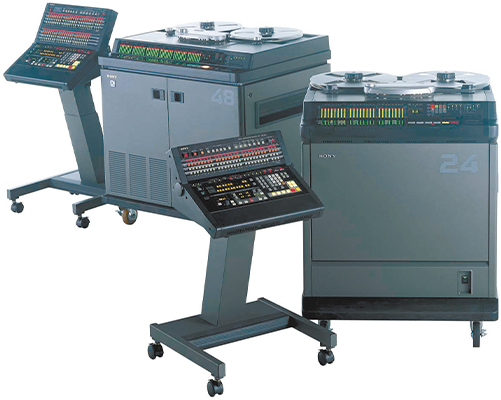
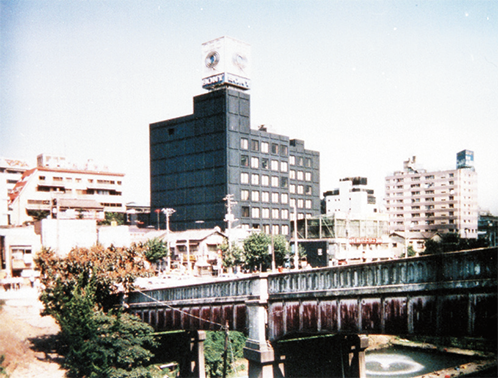
1 : PCM-3324S & RM-3300 (foreground) and PCM-3348 & RM-3348 (background). They both supported the DASH format (Digital Audio Stationary Head), but since the PCM-3348 supported twice the number of tracks, various technical improvements were made.
2 : Old CBS Sony building, also known as “the black building”, where CBS Sony Records (currently, Sony Music Records) at the time had released numerous CDs after the 1980s. Most of them were recorded by PCM-3324s and PCM-3348s. (This building is now sold.)
Sampling functions, variable crossfades, and tape compatibility,
were some of the various features created based on the interviews with recording studios.
As the PCM-3348 became popular around the world, Matsuo, who was one of the users talks about its usability.
“It was very useable, and I’d even say that the layout of its operating controls were very appropriate. For example, when two switches are pushed simultaneously, it won't be useful if your arms were to cross. The appropriate layout was needed, and Sony’s engineers had learned so much from their time spent at recording studios, about the layout, how the switches are stroked, and the timings of punch in/out. The design engineers were clearly pursuing the best form.”
“The sampling function was a very unique feature.” Suzuki continues.
“Selected portions of the recorded sound were able to be sampled in the memory. For example, if the take of the first chorus sounded good and you wanted to use it on the second chorus, the sampling started when you engaged the memory switch while the intended take is being played back, and ends when you stop it at the intended point. When you trigger the sample at the intended point while playing the second chorus, you could record it on the chosen track. This is what we now call copy and paste. But at the time, if you were trying to do the same thing, you originally had to record on a different recorder, and then get it back to the digital multi-track. Also, the variable crossfade feature during punch in was very useful. For example, in slow songs when you wanted to punch in during a phrase with long notes, for example, you could smooth out the curve and modify it according to the source.”
A time code track was also a welcomed feature for recording engineers. Matsuo talks about it.
“This was also available on the PCM-3324, but being able to use a full 48 tracks made a huge impact. This was because with an analog multi-track recorder, in order to do the mix using fader automation on the console, we had to record the time code on an audio track. As well, in order to avoid the time code interfering with the audio signals, adjacent tracks to the time code track had to be kept blank, so that it was really only 22 or 23 tracks, at most, that were able to be used. So, it was superb to be able to use all 48 tracks! Basically, the number of tracks were doubled from the PCM-3324, could use the same tape, and also a 24 track recorded tape was able to have another 24 tracks overdubbed, which made us really happy. It was very easy to add new sounds to older songs which were recorded with the PCM-3324, and we could also replace certain parts, too.”
“But during the development stage, I assume it was not an easy thing to have this compatibility.” Suzuki continues.
“There was nothing unsatisfactory about the sound quality and it was a well-made product. After the mid-1980s, CDs had become the dominant music format and Sony products such as the PCM-3348 for recording, and the PCM-1630 processor or PCM-9000 disc recorder for mastering, were used all over the world. It made me proud to see the PCM-3348, in which I was involved in the development of, as one of the recording engineers, be so loved and widely used.”
Germano stated “Once the 3348s were released, the ability to have 48 digital channels on half inch tape was something that all of our clients gravitated towards.”
“We eventually replaced all of our digital tape recorders with 11 Sony 3348HRs. This tape recorder to this day is the greatest sounding digital tape recorder ever manufactured, in my opinion. It actually would rival AND beat Pro Tools sonically in a side-by-side shootout.”
The 3348 was the crystallization of what professionals really wanted. This was realized by Sony and SME engineers, and as the result, this product became well accepted all over the world.
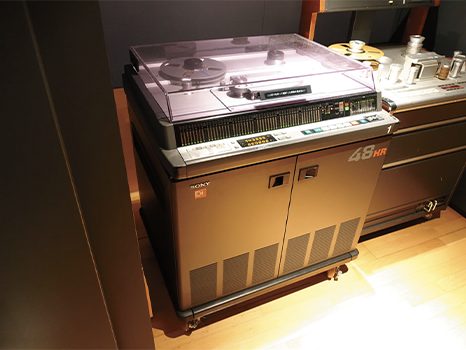
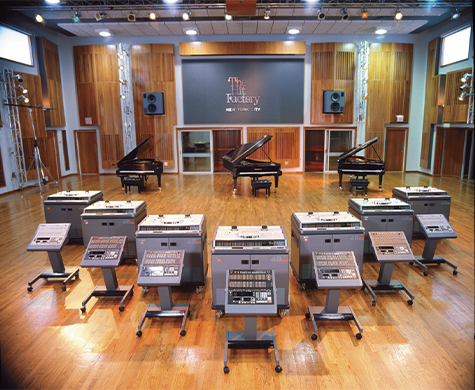
1 : The PCM-3348HR, housed even today in the Sony Music Studio, Tokyo. The original PCM-3348 was able to handle a maximum of 16bit/48kHz, but this device supported up to 24bit/48kHz, and was released in 1997.
2 : PCM-3348HRs, housed in the old Hit Factory, the world famous studio in New York City. The owner Troy Germano had evaluated its sound quality and says, “It actually would rival AND beat modern DAWs sonically, in a side-by-side shootout.”
The engineer Koji Suzuki talks about the MDR-CD900ST
standard monitoring headphone

Whoever has been involved in music production might have at least once seen the MDR-CD900ST monitoring headphone. This was initially developed to be used in the old CBS Sony Shinanomachi studio (currently Sony Music Studio Tokyo) and came to the market in 1989 as a professional audio device. It was released in 1995 to the general consumer, and during the last 30 years it has been used in countless recording situations, most notably in Japan.
Actually, I was involved in the development of these headphones when I was working as an assistant and had shared the concept that this should be a headphone useful for musicians in studios, and also works well with Sony cue boxes. Since this headphone was designed to hear sounds with great detail, it made it easier to perform when used for monitoring during the recording process. Of course, it was highly evaluated from many musicians on a daily basis. For example, there are many singers who say, “I will not use any other headphones since I cannot judge my voice” and probably what they are trying to express sonically was directly delivered. Also, since it was very easy to hear music in a well-balanced way, the engineers at Sony Music Studios Tokyo are still using them today for checking their mixes.
As for servicing these headphones, since it is very easy to replace the parts and get them repaired, these headphones are a good choice for professional applications. For example, very small issues such as replacing the ear pads can easily be done, and from the studio owner’s point of view, it's probably cost efficient. From both a usability and sound quality point of view, they have been highly regarded and supported for a very long time.
Just as a note, the MDR-CD900ST is sold only in the Japanese domestic market, but the similar MDR-V6 and MDR-7506 are more widely known and marketed around the world.
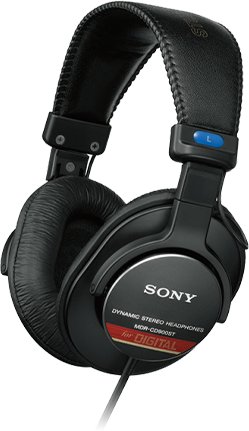
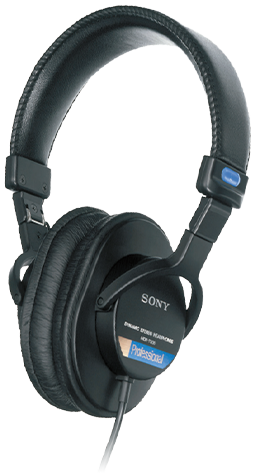
1 : MDR-CD900ST, which had become a Japanese domestic standard recording monitoring headphone since its release in 1989.
2 : MDR-7506, released commonly outside of the Japanese Market.

